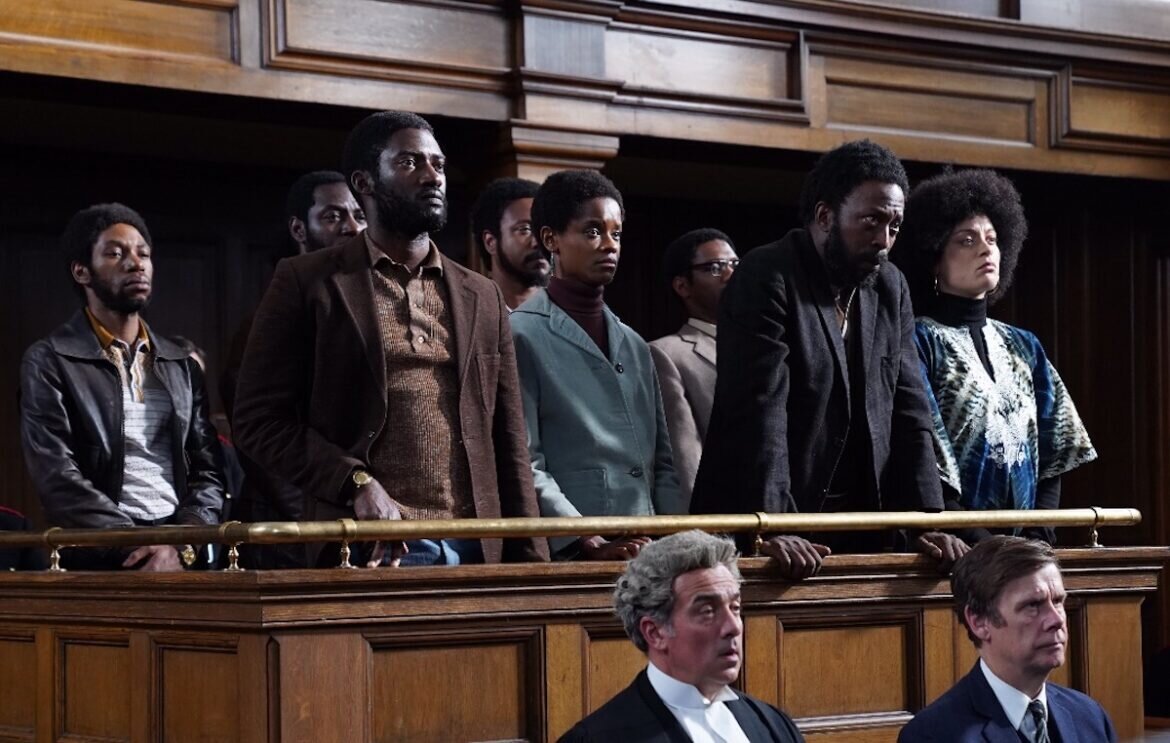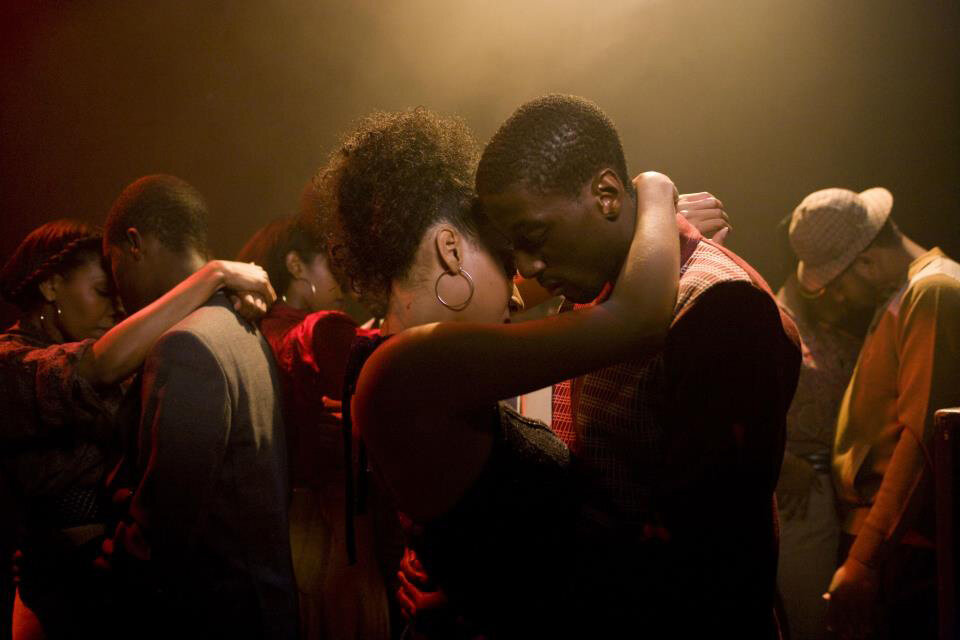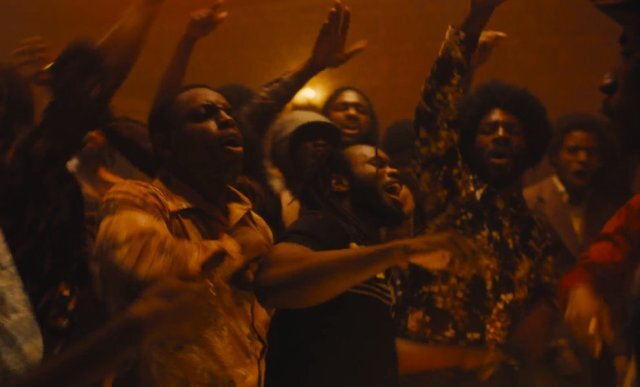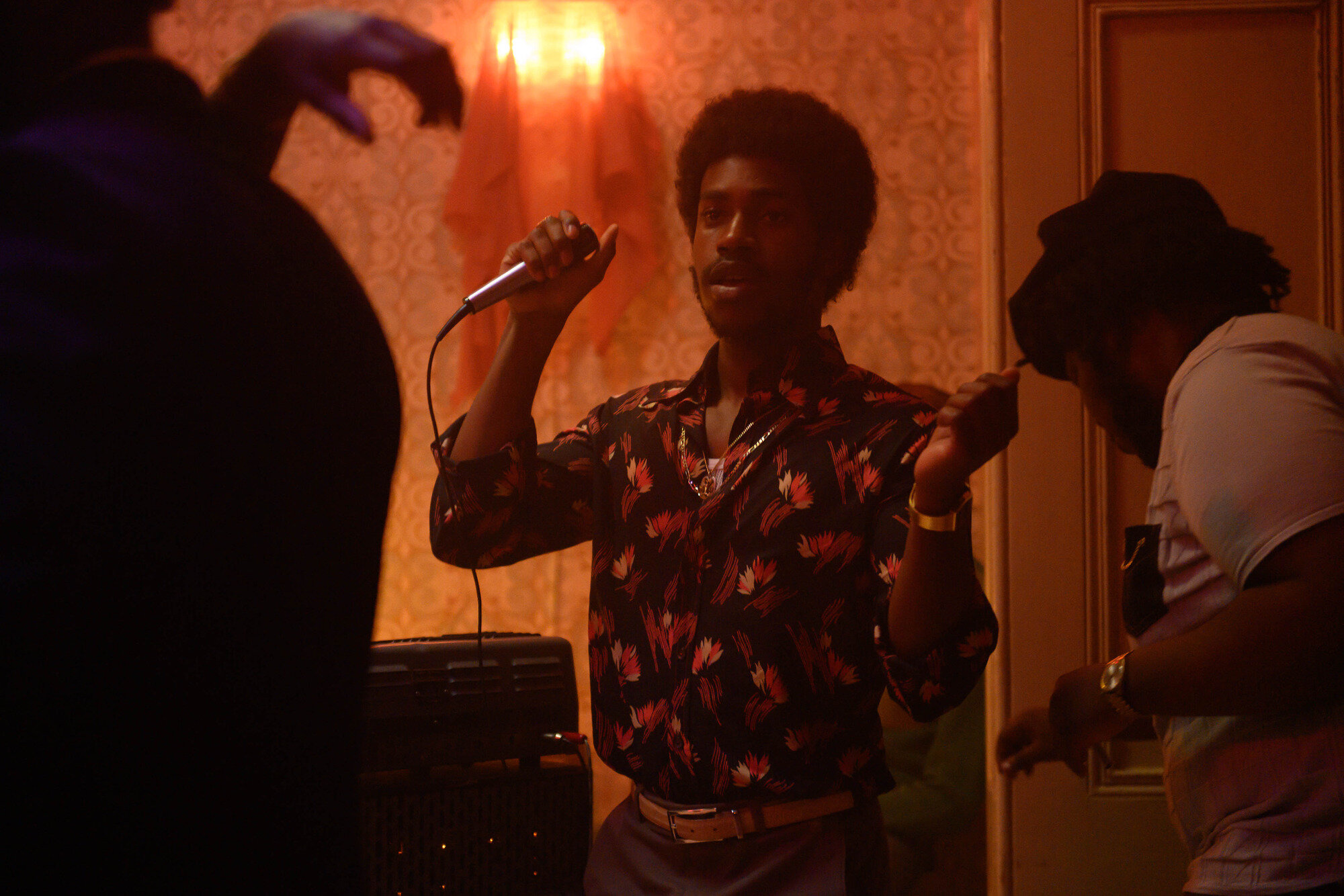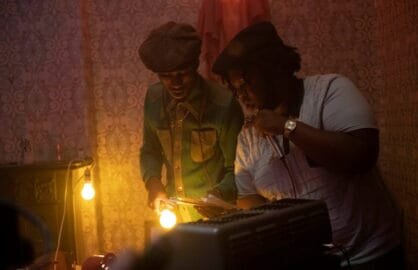New York Film Festival 2020
New York / On-line, September 17 - October 11, 2020
Drake Stutesman
Some films to see:
BEGINNING
2020
Déa Kulumbegashvili
Georgia
125 min.
Georgian filmmaker Dea Kulumbegashvili's debut film, Beginning, is a story of a disintegrating marriage in a small religious community under threat by locals. It is a complicated situation that Kulumbegashvili makes into something oddly simple and cinematically extraordinary. The main character, a woman, Yana (played with an intense use of silence by Ia Sukhitashvili), in a marriage she wants to leave, mother to a young son who is struggling to ignore her, is a Jehovah's Witness in a rural, Georgian Orthodox town in Georgia. Her husband is a leading Jehovah's Witness elder and she, with no official title or pay, organizes events and teaches school. The Jehovah's Witnesses deal with attacks of violence and arson and, for Yana, these also turn into sexual intimidation and rape. For some devout women, the experience is not atypical. Those in isolated spiritual societies within a larger, hostile population often work as teachers, organizers and nurses, as Yana does, while the men take the leadership roles, as her husband has. The women, not infrequently, become objects of male prejudices who project sexual fantasies on to them as either too uptight or too available. (1) Kulumbegashvili's film is set in the narrative of this day-to-day reality women face, that of being physically targeted and remaining socially and individually invisible.
Kulumbegashvili shows two scenes where Yana is attacked. The first is when a man, a plain clothed police officer, surreptitiously enters her home, intimidates her, and forces sex on her in a way that is not shown. Kulumbegashvili creates a feeling of fear by stopping our expectations of what will come next. We watch the man, whom we think, because of the camera angle, will cross the room towards Yana but, instead, the following shot is of him in another room, now next to her. In the second attack, while walking on a marshy riverbank in a forest, Yana is grabbed and raped. The rape is filmed from a distance but close enough to see the struggle in detail. They fight, he rapes her and then staggers up and wobbles away. These are simple, ordinary devices but Kulumbegashvili makes them seem - not abrupt - but rather more true to life, as if the framing follows the way one perceives psychologically rather than the way one sees with one's eyes. It is a quality reminiscent of the films of Russian director Kira Miratova whose ability to convey a scene minimally also has a sensuality that conveys living and lived life. Kulumbegashvili's frame can be pinched, as if it is too tight, constricting the characters, reflecting the lives of the Georgian Jehovah's Witnesses, pressured as outsiders, and of Yana, often seen tightened in the frame, reflecting the tightness in her life. However, Kulumbegashvili's holding of the frame for long periods, into which people come and go or an event occurs, such as a building catching fire, somehow creates a frame that is not static. It seems part of the action, as if the camera's framing is as alive as the people. Her film frame is like a living thing.
In fashioning an atmosphere of real violence, Kulumbegashvili works her camera as if, literally, it is a kind of consciousness. She focuses our attention on movement and stillness as if they are the complex narratives that are never spoken between the characters: through frames, camera motion, distances that remain distant even though the camera tracks into them or a person enters or leaves the space. She affects a sensation in the film that levels every part of it into an equality: culture, context, nature, camerawork and story are all equal. The 'frame' is still and we, the viewers, fill it. This has a surreal quality. It becomes a technique, bringing out the surreal feeling that threat induces, in its shock and in its acceptance, and the film's ending, in particular, is an artistic feat of drawing these elements together. Though the film has terror, violence, rape, neglect, and helplessness, Kulumbegashvili evokes an organic sense of life. The woman is placed in a frame that confines yet we always see her, almost feel her, as a breathing, perceiving living being.
A must see, engrossing and original film.
SMALL AXE ANTHOLOGY
Mangrove
Lovers Rock
Red, White and Blue
2020
Director: Steve McQueen
UK
Steve McQueen, a British artist with Trinidadian and Grenadian heritage, is in part a video artist with a strong art gallery international presence (in the 1990s he was represented by the Marian Goodman Gallery in New York/Paris and the Thomas Dane Gallery in London, in 1999 was awarded Britain's Turner Prize, and in 2001 exhibited at the Tate), and in part a film director with an international audience and establishment recognition (receiving Oscar, BAFTA and multiple other awards). He walks easily between these two worlds, without emphasizing the value of one form of art over the other. In this, he has created a unique presence. McQueen, in breaking into both avant-garde and more establishment video and film, has carved his own way and, with Small Axe, the overall title of a series of films first broadcast on the BBC, he has expanded his niche. The 2020 New York Film Festival screened Mangrove, Lovers Rock and Red, White and Blue, three films out of McQueen's 2020 Small Axe film-quintet. Varying in length, each one focuses on Black British life, in both the political and the domestic spheres. Two of the films are taken from real incidents (Mangrove and Red, White and Blue) and one from fiction (Lovers Rock). Though the films take a fairly simple narrative form, McQueen uses an artificiality that is the mark of his artwork. This artifice, almost Brechtian at times, appears throughout, especially in the way that he frames his characters and in his use of color as a way to convey emotion not laid out in the script. In looking at the intensity of racism in Britain and the experience of Black citizens/subjects, in particular from the 1960s to the 80s, McQueen places the domestic in each of the three films - the restaurant table in Mangrove, the kitchen table in Red, White and Blue, and the house in Lovers Rock. Though the films are in a constant context of disunity, prejudice, and destruction as we see the main characters living within the pressures of the British system, McQueen imbues each film with harmony - in the unity of a group (appearing in gatherings as family, as restaurant patrons, as protesters, as activists, as defendants, as dancers, and as a worker among workers) and in unity as people finding sanctuary with each other and within themselves. In the first film, Mangrove, about an arrest and trial, in the courtroom scenes, the group (the nine people who have been arrested, known as the Mangrove Nine) are bunched together, sitting in the courtroom box for defendants, and McQueen places them in such a way that they form one body, much as twelfth century European illuminated manuscripts grouped their figures to make them distinct and to have them perceived as a unit of likeness. There is a solidarity perceptible in this image. And there is an artificiality as they become one body. In the Fall 2020 issue of Framework, FW61-2, William J. Simmons, in his introduction to his Steve McQueen interview, described the breadth of this "body" as it moves across McQueen's work, in his art and through the years - "We see McQueen's body in the process of becoming, consuming, and making discourse, and we derive some form of pleasure from engaging with that process, if only or necessarily at a distance." (2)
MANGROVE
2020
Director: Steve McQueen
UK
126 min.
Centering on the 1971 arrest and trial of the Mangrove Nine - Frank Crichlow, the British Trinidadian owner of the Mangrove restaurant, specializing in Trinidadian food, and eight other London residents - who were charged with inciting riots, Mangrove moves the viewer from the sunlit, decorated walls of the Mangrove restaurant, a small West London eatery, to the dark walls of the enclosed British courthouse where these Nine were tried. The two hour plus film is virtually divided in half with this construct: the first hour takes place in the restaurant, in homes, and in streets, and the second hour takes place in the court. Opening with close-ups of men smoking and drinking, lit in a dense, green hued yellowy light, McQueen sets up his sense of the materiality of film (as a body) and he makes it obvious that the materiality in the lighting (as a narrative form) is as much the "story" of Mangrove as the plotline is the story of Mangrove. McQueen builds the narrative through light and dark, monochrome and hue, primary color and pastel. His characters enter into these concentrations of light, brilliantly shot by McQueen's cinematographer, Shabier Kirchner (who also shot Crystal Mossell's Skate Kitchen). The trial ends in acquittal (though there were two more trials - also acquittals), and Critchlow (solemnly played by Shaun Parkes) in the last scene, appears outside his restaurant, in the same green-hued hazy light in which he first appeared, bringing the film full circle.
LOVERS ROCK
2020
Director: Steve McQueen
UK
68 min.
Though McQueen places the domestic in each of the three films, Lovers Rock, which takes place, almost entirely, in a Blues, the Black British slang for an in-house party, which has a cover charge to meet basic food, music and drink expenses, is, at heart, the Small Axe quintet's core world - that of the domestic. In Lovers Rock, it is an interior (the house). It has a central locale (the rooms and the garden). And, as a dance, its focus is on the partying people. McQueen's cinematographer, Shabier Kirchner, slides his camera through the house, through the crowd of Lovers Rock dancers and lounging partygoers, lit in green-tinged amber, black, and blue hues, giving it a misty coherence. McQueen often focuses on the bodies - arms, backs, legs, necks, and separations and embraces - as a way of adding to that sense of coherence. And the bodies are grouped as almost one physical body (a device found in the other Small Axe films). But in Lovers Rock, McQueen makes lighting so much part of the entire scene that it almost feels substantial, a literal presence, juxtaposed with people brought together as moving bodies that intermittently form a whole. He structures the film around this sense of grouping.
The film opens with a snapshot of what will be the film's repeating structure of closure and openness. The first shot, a moving train in darkness; second shot, a closeup of a pale blue closed door; third shot, an indistinct female figure sneaking out of a darkened house at night, with her white shoes in hand; fourth shot, a bright house interior, with three bay windows full of white light, people talking and moving furniture, women cooking in the kitchen and men setting up turntables and playing music. It sets up the centrality of "house" - as the place that is full of life and full of action. There is hostility, disappointment, and even potential assault in the party, but the film gives the party a status - it is a rock (as a foundation) and a place for love. The film is a constant repetition of the opening structure: the way in which the mobility of the distant public train is juxtaposed with the door that is closed is then countered by pairing the woman sneaking out in the dark with the bright, open doors and windows of the party house where she is going. This opening and closing form is repeated in the film's simple story of boy-meets-girl. McQueen creates, in this sense, an interior within an interior. Lovers Rock is a story about foundation, relationship and meeting and its sense of this "rock" as a place of solidity and fluidity is bracketed by the stories of attacks which Mangrove and Red, White and Blue tell. Lovers Rock is made to be, in this way, the heart, the rock of the Black community.
RED, WHITE AND BLUE
2020
Director: Steve McQueen
UK
80 min.
The arc of Red, White and Blue is in the relationship between a British Jamaican father and son, who are at odds over the son's police career. This arc covers the entire narrative but the film gives the father and son a moment of union in the last scene, at a kitchen table. The true story, about Leroy Logan (played by John Boyega with sympathetic depth) who joined London's Metropolitan police in 1983, follows the racism he encounters as he tries to do his job. Logan entered the constabulary partly with a desire for reform and, despite years of racist harassment and treachery from other police, as he is left unassisted and his advancement is blocked, will not leave the force. The film also follows the trajectory of Logan's pride in what he accomplishes and the toughness he develops in order to live with both the job's racism and his deepening sense of self. His father, who had been beaten by police, cannot tolerate his son's career. The story starts with Logan's father angrily protecting his ten-year old son from police who are hassling the little boy as he stands, in his school uniform, in front of his school. And the film ends with the father and son, adult men, sitting at the kitchen table together. The tone is not one of reconciliation, but it is a tone of a kind of joining together that can't be forced apart.
A unique set of films about British Black life from artist Steve McQueen.
NOTES
1 For other examples see: Coburn, Carol K. and Martha Smith, "City Sisters: The Sisters of St. Joseph in Missouri, 1836-1920," Women in Missouri History: In Search for Power and Influence, eds. Lee Ann Whites, Mary C. Neth, Gary R. Kremer (Columbia: University of Missouri Press, 2004) 82-100.
2 Framework 61-2, Fall 2020, p 62, William J. Simmons, "Every Story Has Already Been Told: Steven McQueen: Interview and Portfolio."


